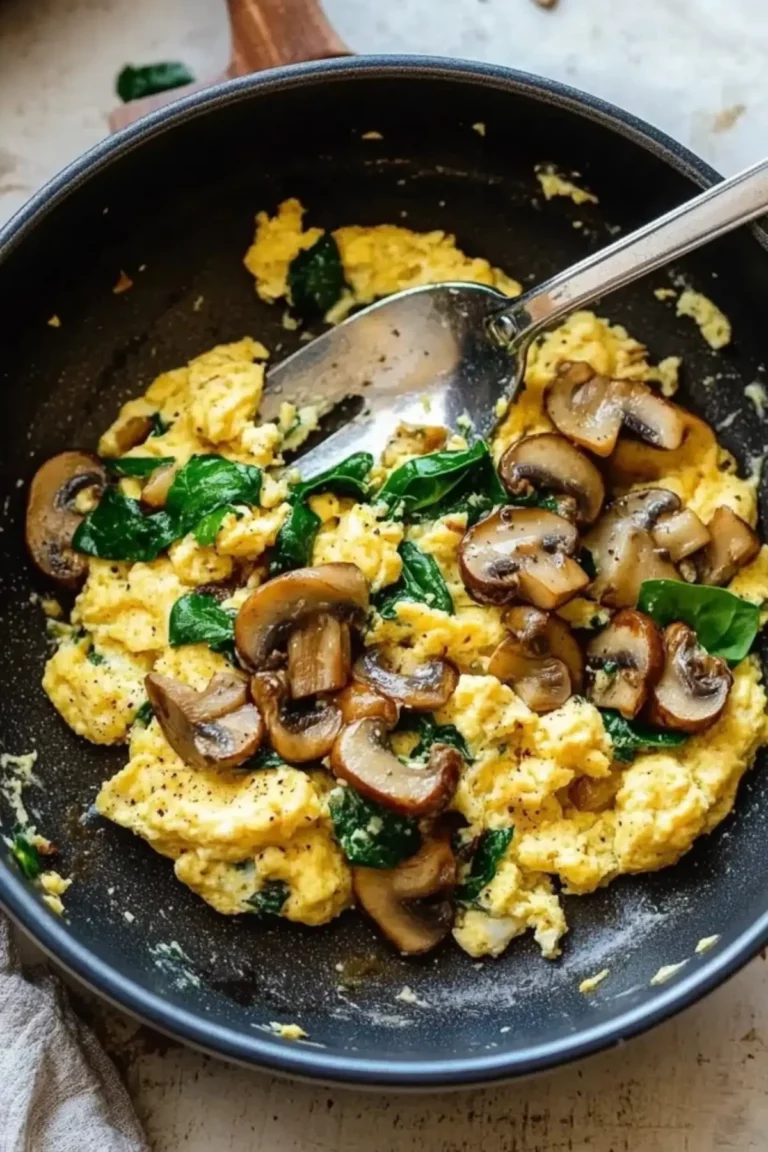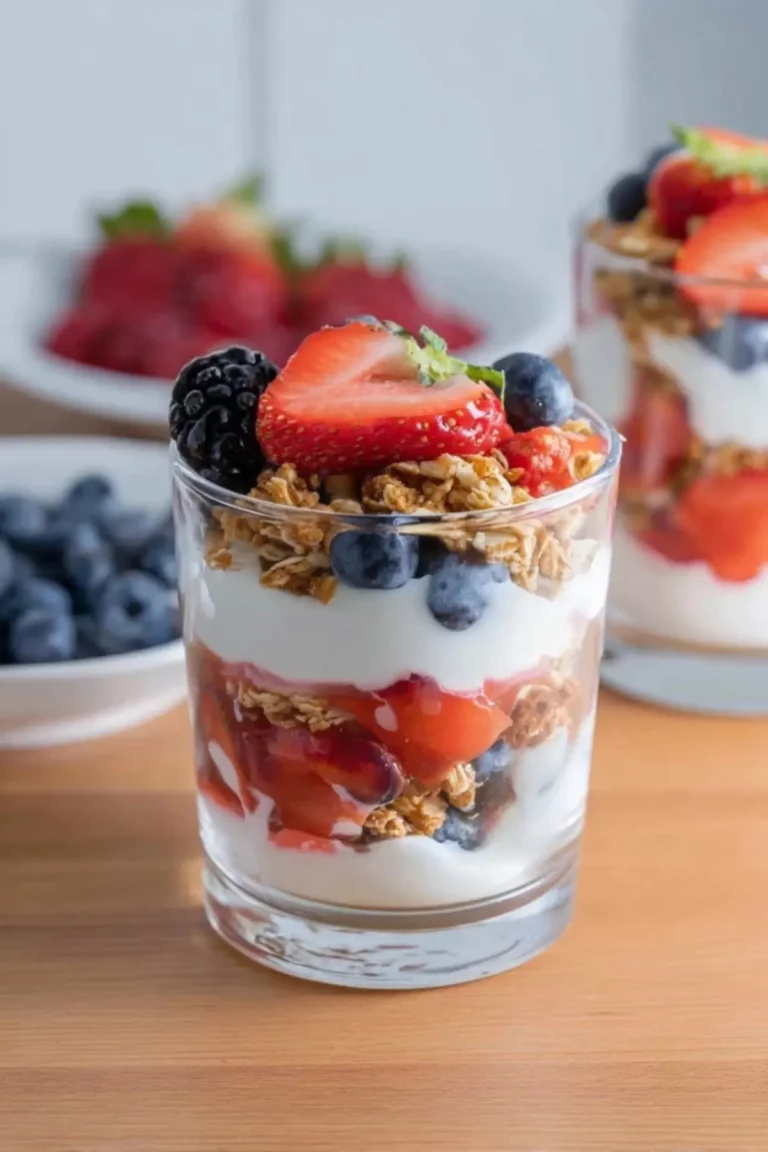There’s nothing quite like the smell of fresh bread baking in the oven. It brings warmth and comfort to any home, and the satisfaction of making your own loaf from scratch is unmatched. When I first started baking bread, I was intimidated by the thought of kneading, proofing, and shaping. But then I discovered no-knead bread, and everything changed. This Seeded Oat Bread is one of the easiest artisan-style loaves you’ll ever make, and it looks and tastes like it came straight from a bakery.
This bread has a crusty exterior, a soft, chewy interior, and a delightful crunch from the mix of seeds and oats. It’s perfect for beginner bakers because it requires no kneading, no fancy equipment, and very little hands-on time. Whether you’re making it for sandwiches, to pair with soup, or to simply enjoy with butter, this seeded oat bread is a must-try.
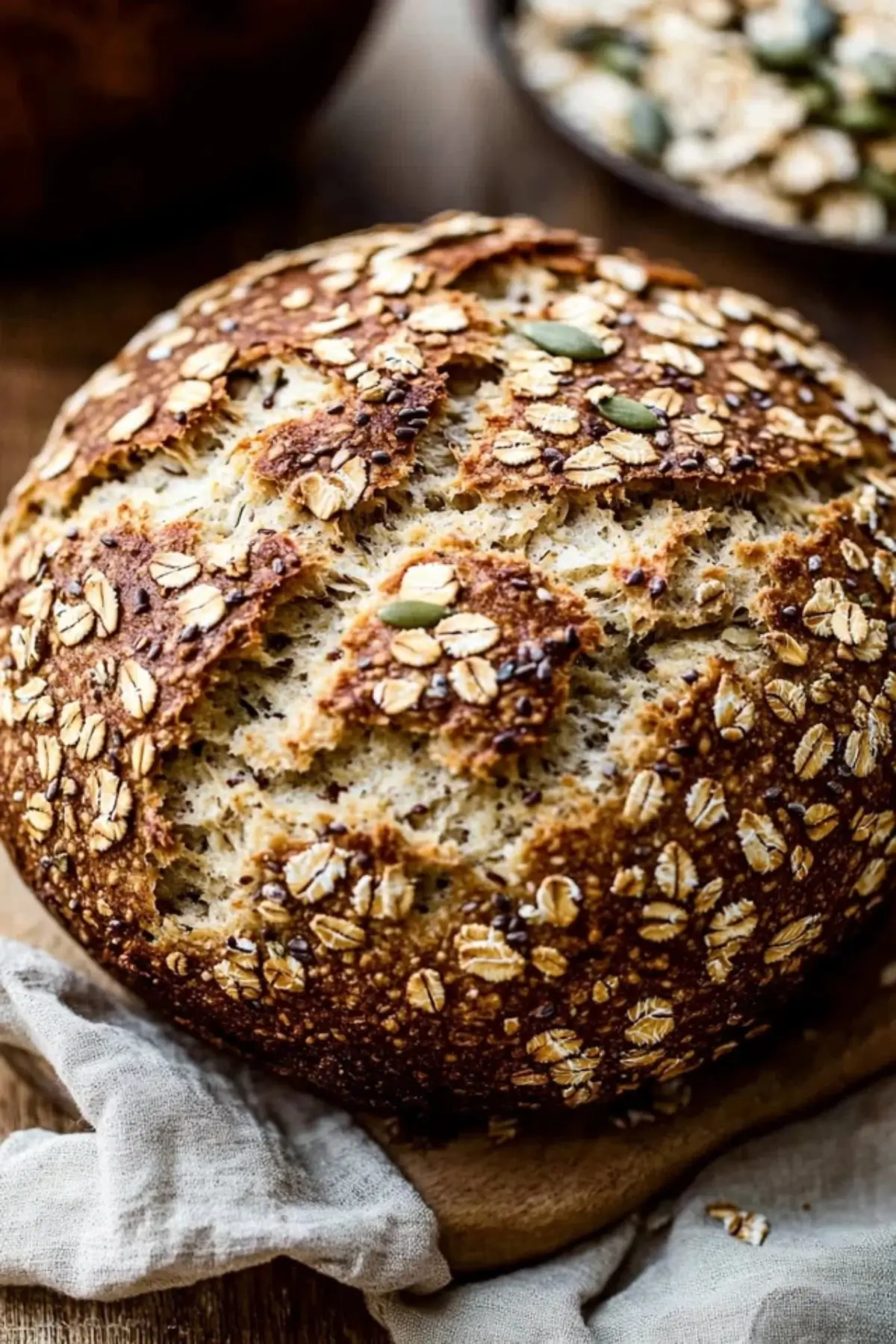
Why This Recipe is Special
- No kneading required: The dough comes together with just a simple mix—no need for a stand mixer or extensive kneading.
- Hands-off process: Most of the time is spent waiting for the dough to rise and develop flavor.
- Nutrient-packed: Loaded with oats, flaxseeds, sunflower seeds, and pumpkin seeds, this bread is high in fiber, protein, and essential nutrients.
- Versatile: Works great with different toppings, spreads, or as a side for soups and stews.
- Beginner-friendly: Even if you’ve never baked bread before, this recipe is easy to follow with great results.
Ingredients and Preparation
Each ingredient in this bread contributes to its texture, flavor, and nutritional value.
Key Ingredients
- Bread flour: Provides structure and chewiness, making the loaf more stable and giving it a slightly dense texture. If needed, all-purpose flour can be used, but the texture may be softer.
- Old-fashioned oats: Soak up moisture as the dough rises, adding a slight chew and nutty flavor. Quick oats can be used, but they may not provide the same texture.
- Coarse sea salt: Enhances the flavor of the bread and balances the sweetness from the honey.
- Instant yeast: Helps the dough rise efficiently. Active dry yeast can be used, but the rise time may be slightly longer.
- Pumpkin seeds, sunflower seeds, and flaxseeds: Add crunch, flavor, and a boost of nutrients. Feel free to customize with sesame seeds, poppy seeds, or chia seeds.
- Honey: Adds a slight sweetness and helps with moisture retention, keeping the bread from drying out.
- Warm water: Hydrates the ingredients and activates the yeast for proper fermentation.
Alternative Ingredient Suggestions
- For a heartier loaf, substitute 1 cup of bread flour with whole wheat flour.
- Swap honey for maple syrup or agave for a vegan version.
- Use a different seed mix based on availability or preference.
Step-by-Step Instructions
Prepare the dough: In a large mixing bowl, whisk together the bread flour, yeast, oats, seeds, and salt. In a separate bowl, mix warm water with honey until dissolved, then pour it over the dry ingredients. Stir with a wooden spoon or spatula until the dough comes together. It will be sticky and slightly shaggy—this is normal.
First rise: Cover the bowl with plastic wrap or a clean towel and let the dough rise at room temperature for 3 hours. The dough will expand and develop air bubbles.
Refrigeration for better flavor: For the best flavor and texture, transfer the covered dough to the refrigerator and let it rest for at least 12 hours or up to 3 days. This slow fermentation enhances the taste and creates a better crumb structure.
Shape the dough: Lightly flour a baking sheet or a work surface. Using well-floured hands, shape the dough into a round ball, being careful not to deflate it too much. Place it on the prepared baking sheet.
Final rise and preheat oven: Loosely cover the dough with a towel and let it rest for 45 minutes. Meanwhile, preheat the oven to 425°F (218°C).
Score the dough: Just before baking, sprinkle the dough with extra oats and seeds. Use a sharp knife or bread lame to score an X or a single slash on top—this helps control how the bread expands in the oven.
Bake the bread: If using a baking sheet, place the shaped dough directly in the oven. For a crispier crust, place a shallow pan filled with hot water on the bottom rack to create steam. Bake for 40 minutes or until the crust is golden brown and the bread sounds hollow when tapped.
Cool before slicing: Allow the bread to cool for at least 20 minutes before slicing. This helps set the interior and prevents it from becoming gummy.
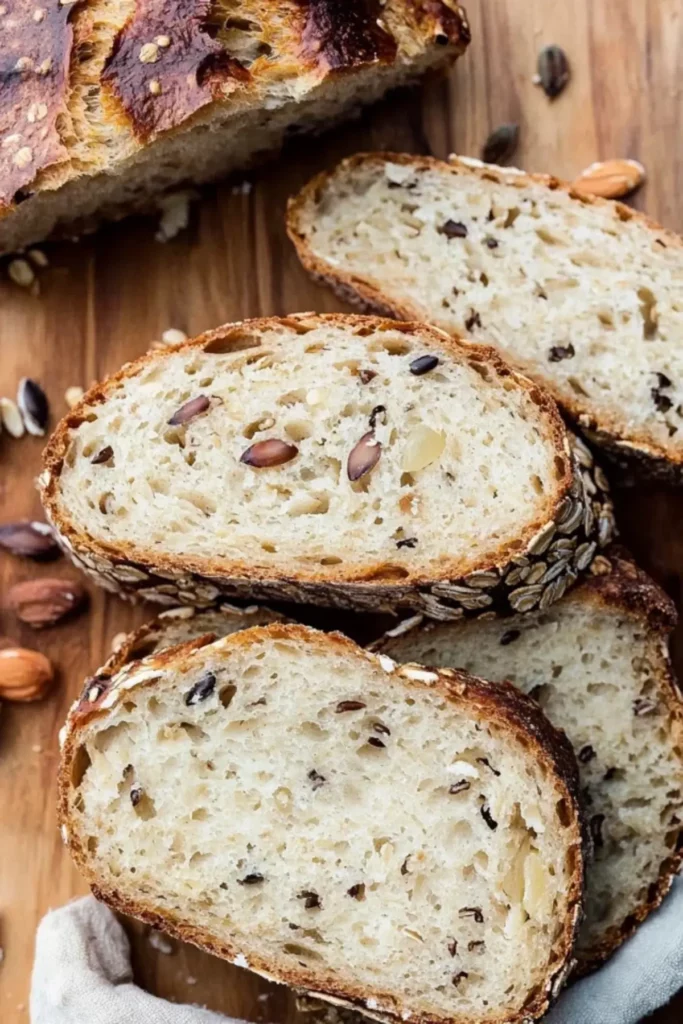
Beginner Tips and Notes
- How to tell if the bread is done: Tap the bottom of the loaf—if it sounds hollow, it’s ready. Alternatively, use a food thermometer; the internal temperature should be around 195°F (90°C).
- Making the crust crispier: Bake in a Dutch oven or place a small tray of boiling water in the oven to create steam.
- Storing leftovers: Store at room temperature in a bread bag or wrapped in a kitchen towel for up to 3 days. For longer storage, slice and freeze the bread.
- Avoiding dense bread: Make sure the dough has enough time to rise properly. If using active dry yeast, the rise may take longer.
Serving Suggestions
- With butter and honey: Enjoy a warm slice with butter and a drizzle of honey for a simple treat.
- As a side for soups and stews: This hearty bread pairs well with creamy soups or hearty stews.
- For sandwiches: Slice it thick and use it for sandwiches with fresh veggies and protein.
- Avocado toast: Top with mashed avocado, sea salt, and a sprinkle of chili flakes for a delicious snack.
Conclusion
This Seeded Oat Bread is proof that making homemade bread doesn’t have to be complicated. With minimal effort, you can create a bakery-quality loaf that’s crusty, chewy, and loaded with wholesome ingredients. Whether you’re a beginner or an experienced baker, this recipe is a must-try.
Have you tried this recipe? Share your experience in the comments below and let me know how it turned out
FAQ About Seeded Oat Bread
Can I use all-purpose flour instead of bread flour?
Yes, you can substitute all-purpose flour for bread flour, but the texture may be slightly softer and less chewy. Bread flour provides a stronger structure, making the bread more stable and giving it a bakery-style crust.
Do I have to refrigerate the dough overnight?
No, but refrigerating the dough for at least 12 hours enhances the flavor and texture. If you’re short on time, you can bake the bread after the initial 3-hour rise, but it may not have the same depth of flavor.
How do I know if the bread is fully baked?
Tap the bottom of the loaf—if it sounds hollow, it’s done. For accuracy, use an instant-read thermometer; the internal temperature should be around 195°F (90°C).
More Relevant Recipes
- BLUEBERRY CREAM CHEESE BREAD
- Sweet Alabama Pecan Bread
- Dutch Oven No Knead Bread (with perfect crusty crust!) – Bowl of Delicious
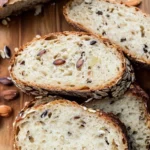
Seeded Oat Bread (No Kneading!)
- Total Time: 14-16 hours (including resting time)
- Yield: 1 loaf 1x
- Diet: Vegetarian
Description
This Seeded Oat Bread is an easy homemade artisan-style loaf with a crusty exterior, chewy inside, and a delicious mix of oats and seeds. Made with a simple mix-and-rest method, this recipe is beginner-friendly and requires minimal effort. Perfect for sandwiches, toast, or serving alongside soups and stews
Ingredients
For the Dough
- 3 cups (390g) bread flour
- 1 cup (85g) old-fashioned rolled oats
- 2 teaspoons (6g) instant yeast
- 2 teaspoons coarse sea salt
- ¼ cup (30g) unsalted pumpkin seeds (pepitas)
- ¼ cup (30g) sunflower seeds
- 2 tablespoons (18g) flaxseeds or sesame seeds
- 2 tablespoons (43g) honey
- 1½ cups (360ml) warm water (about 95°F / 35°C)
For the Topping
- 1 tablespoon (5g) rolled oats
- 1 tablespoon (8g) pumpkin seeds
- 1 tablespoon (8g) sunflower seeds
- 1 teaspoon flaxseeds or sesame seeds
Instructions
- Prepare the dough: In a large mixing bowl, whisk together the bread flour, yeast, oats, salt, and seeds. In a separate bowl, combine the warm water and honey, stirring until dissolved. Pour the wet mixture into the dry ingredients and stir with a wooden spoon or spatula until fully combined. The dough will be sticky and shaggy.
- First rise: Cover the bowl with plastic wrap or a clean towel and let the dough rise at room temperature for 3 hours. The dough will expand and develop air bubbles, spreading out more than rising upward.
- Refrigerate for better flavor: Transfer the covered dough to the refrigerator and let it rest for at least 12 hours or up to 3 days. This slow fermentation enhances the flavor and creates a better texture.
- Shape the dough: Lightly dust a baking sheet with flour or cornmeal. Using floured hands, gently shape the dough into a round ball, being careful not to deflate it too much. Transfer it to the prepared baking sheet.
- Final rise and preheat oven: Loosely cover the dough with a towel and let it rest for 45 minutes while preheating the oven to 425°F (218°C).
- Score and top the dough: Sprinkle the dough with additional oats and seeds. Use a sharp knife or bread lame to make a shallow cut or X on the top to help control expansion during baking.
- Bake the bread: Place the shaped dough into the oven and bake for 40 minutes, or until the crust is golden brown and firm. If using a baking sheet, place a shallow pan filled with boiling water on the bottom oven rack to create steam for a crispier crust.
- Cool before slicing: Let the bread cool for at least 20 minutes before slicing. This allows the crumb to set and prevents it from becoming gummy.
Notes
- For a crispier crust, bake in a Dutch oven or use the steam method with a pan of boiling water in the oven.
- If using active dry yeast instead of instant yeast, allow an additional 30 minutes for the first rise.
- Leftover bread can be frozen for up to 3 months. Slice before freezing for easy reheating.
- This bread works well with different seed variations, such as sesame, poppy, or hemp seeds.
- Prep Time: 15 minutes
- Cook Time: 40 minutes
- Category: Bread
- Method: Baking
- Cuisine: American
Nutrition
- Serving Size: 1 slice (1/10 of loaf)
- Calories: 170
- Sugar: 3g
- Sodium: 270mg
- Fat: 5g
- Saturated Fat: 0.5g
- Unsaturated Fat: 4g
- Trans Fat: 0g
- Carbohydrates: 28g
- Fiber: 3g
- Protein: 6g
- Cholesterol: 0mg




